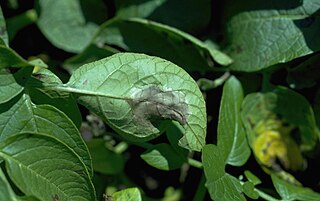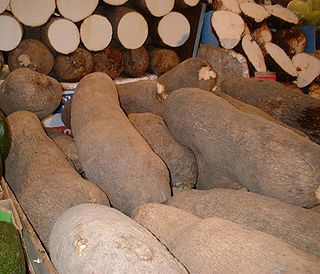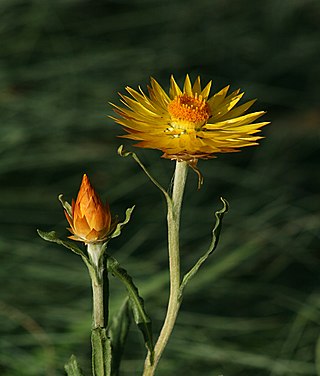
The potato is a starchy food, a tuber of the plant Solanum tuberosum and is a root vegetable native to the Americas. The plant is a perennial in the nightshade family Solanaceae.

Tubers are a type of enlarged structure used as storage organs for nutrients in some plants. They are used for the plant's perennation, to provide energy and nutrients for regrowth during the next growing season, and as a means of asexual reproduction. Stem tubers form thickened rhizomes or stolons ; well known species with stem tubers include the potato and yam. Some writers also treat modified lateral roots under the definition; these are found in sweet potatoes, cassava, and dahlias.

Phytophthora infestans is an oomycete or water mold, a fungus-like microorganism that causes the serious potato and tomato disease known as late blight or potato blight. Early blight, caused by Alternaria solani, is also often called "potato blight". Late blight was a major culprit in the 1840s European, the 1845–1852 Irish, and the 1846 Highland potato famines. The organism can also infect some other members of the Solanaceae. The pathogen is favored by moist, cool environments: sporulation is optimal at 12–18 °C (54–64 °F) in water-saturated or nearly saturated environments, and zoospore production is favored at temperatures below 15 °C (59 °F). Lesion growth rates are typically optimal at a slightly warmer temperature range of 20 to 24 °C.

In botany and dendrology, a rhizome is a modified subterranean plant stem that sends out roots and shoots from its nodes. Rhizomes are also called creeping rootstalks or just rootstalks. Rhizomes develop from axillary buds and grow horizontally. The rhizome also retains the ability to allow new shoots to grow upwards.

Sprouting is the natural process by which seeds or spores germinate and put out shoots, and already established plants produce new leaves or buds, or other structures experience further growth.

Solanine is a glycoalkaloid poison found in species of the nightshade family within the genus Solanum, such as the potato, the tomato, and the eggplant. It can occur naturally in any part of the plant, including the leaves, fruit, and tubers. Solanine has pesticidal properties, and it is one of the plant's natural defenses. Solanine was first isolated in 1820 from the berries of the European black nightshade, after which it was named. It belongs to the chemical family of saponins.

Brassica oleracea is a plant species from family Brassicaceae that includes many common cultivars used as vegetables, such as cabbage, broccoli, cauliflower, kale, Brussels sprouts, collard greens, Savoy cabbage, kohlrabi, and gai lan.

The yacón is a species of perennial daisy traditionally grown in the northern and central Andes from Colombia to northern Argentina for its crisp, sweet-tasting, tuberous roots. Their texture and flavour are very similar to jícama, mainly differing in that yacón has some slightly sweet, resinous, and floral undertones to its flavour, probably due to the presence of inulin, which produces the sweet taste of the roots of elecampane, as well. Another name for yacón is Peruvian ground apple, possibly from the French name of potato, pomme de terre. The tuber is composed mostly of water and fructooligosaccharide.

Russet Burbank is a potato cultivar with dark brown skin and few eyes that is the most widely grown potato in North America. A russet type, its flesh is white, dry, and mealy, and it is good for baking, mashing, and french fries (chips). It is a common and popular potato.

Yam is the common name for some plant species in the genus Dioscorea that form edible tubers. The tubers of some other species in the genus, such as D. communis, are toxic. Yams are perennial herbaceous vines cultivated for the consumption of their starchy tubers in many temperate and tropical regions, especially in West Africa, South America and the Caribbean, Asia, and Oceania. The tubers themselves, also called "yams", come in a variety of forms owing to numerous cultivars and related species.

Xerochrysum subundulatum is a flowering plant in the family Asteraceae, native to Australia, growing in Victoria, New South Wales and Tasmania.

α-Chaconine is a steroidal glycoalkaloid that occurs in plants of the family Solanaceae. It is a natural toxicant produced in green potatoes and gives the potato a bitter taste. Tubers produce this glycoalkaloid in response to stress, providing the plant with insecticidal and fungicidal properties. It belongs to the chemical family of saponins. Since it causes physiological effects on individual organism, chaconine is considered to be defensive allelochemical. Solanine is a related substance that has similar properties.

Chlorpropham or CIPC is a plant growth regulator and herbicide used as a sprout suppressant for grass weeds, alfalfa, lima and snap beans, blueberries, cane fruit, carrots, cranberries, ladino clover, garlic, seed grass, onions, spinach, sugar beets, tomatoes, safflower, soybeans, gladioli and woody nursery stock. It is also used to inhibit potato sprouting and for sucker control in tobacco. Chlorpropham is available in emulsifiable concentrate and liquid formulations.

Solanidine is a poisonous steroidal alkaloid chemical compound that occurs in plants of the family Solanaceae, such as potato and Solanum americanum. Human ingestion of solanidine also occurs via the consumption of the glycoalkaloids, α-solanine and α-chaconine, present in potatoes. The sugar portion of these glycoalkaloids hydrolyses in the body, leaving the solanidine portion. Solanidine occurs in the blood serum of normal healthy people who eat potato, and serum solanidine levels fall markedly once potato consumption ceases. Solanidine from food is also stored in the human body for prolonged periods of time, and it has been suggested that it could be released during times of metabolic stress with the potential for deleterious consequences. Solanidine is responsible for neuromuscular syndromes via cholinesterase inhibition.
The Ranger Russet is a late-maturing potato that is used for baking and processing into fries. It was originally bred by Joseph J. Pavek of the USDA in Aberdeen, Idaho, and released jointly by the USDA and the agricultural stations of Idaho, Washington, Oregon and Colorado in 1991. Ranger Russet is not under plant variety protection. It yields medium to high numbers of tubers with a short dormancy period.
The sweet potato is a very important crop for subsistence farmers in Africa and developing countries in other regions. Its relatively short growing period, tolerance to drought and high yield from poor soils lead to its use as a famine reserve for many of these households. However, it is a highly perishable food source that is susceptible to destruction by microorganisms, metabolic spoilage, physical destruction and pests. Therefore, it is not generally stored for long after harvest. This is a major barrier for the optimal use of the crop and causes much waste.

A staple food, food staple, or simply a staple, is a food that is eaten often and in such quantities that it constitutes a dominant portion of a standard diet for an individual or a population group, supplying a large fraction of energy needs and generally forming a significant proportion of the intake of other nutrients as well. For humans, a staple food of a specific society may be eaten as often as every day or every meal, and most people live on a diet based on just a small variety of food staples. Specific staples vary from place to place, but typically are inexpensive or readily available foods that supply one or more of the macronutrients and micronutrients needed for survival and health: carbohydrates, proteins, fats, minerals, and vitamins. Typical examples include grains, seeds, nuts and root vegetables. Among them, cereals, legumes and tubers account for about 90% of the world's food calories intake.

Maleic hydrazide, often known by the brand name Fazor is a plant growth regulator that reduces growth through preventing cell division but not cell enlargement. It is applied to the foliage of potato, onion, garlic and carrot crops to prevent sprouting during storage. It can also be used to control volunteer potatoes that are left in the field during harvesting. It was first identified in the 1940s but was not used commercially in the United Kingdom until 1984. The banning of chlorpropham as a sprout suppressant in 2019 has led renewed interest in how maleic hydrazide can be used in potatoes.

1,4-Dimethylnaphthalene (1,4DMN) is a plant growth regulator that occurs naturally in potato tubers, preventing them from sprouting. Synthetic forms such as 1-4SIGHT are applied to potatoes during storage.
Diisopropylnaphthalenes (DIPN) is a solvent for carbonless copy paper. The oil consists of a mixture of isomers of diisopropylnaphthalene. Some key properties are broad liquid range, low volatility, and low toxicity. DIN is also known as Kureha Micro Capsule Oil.

















